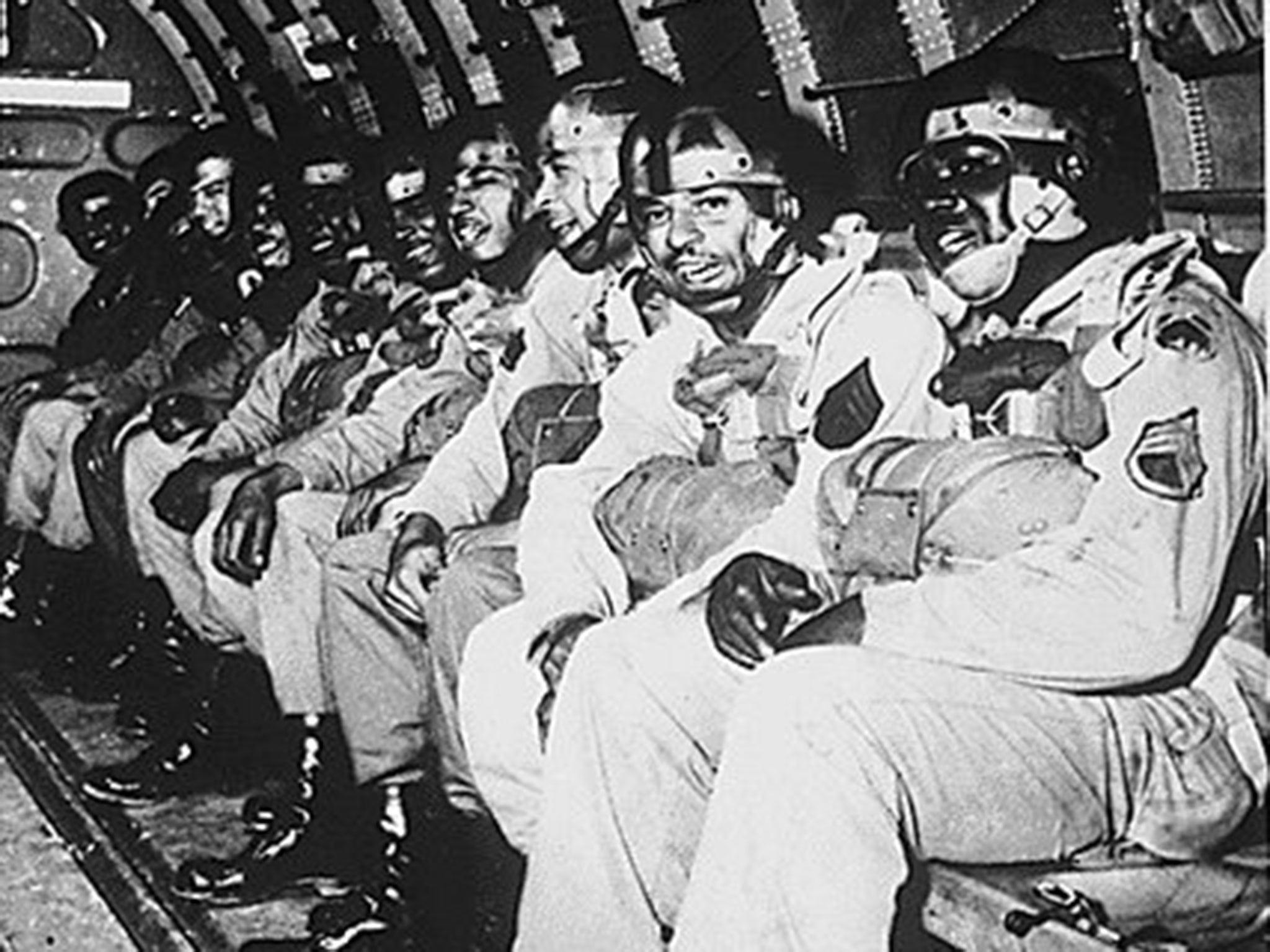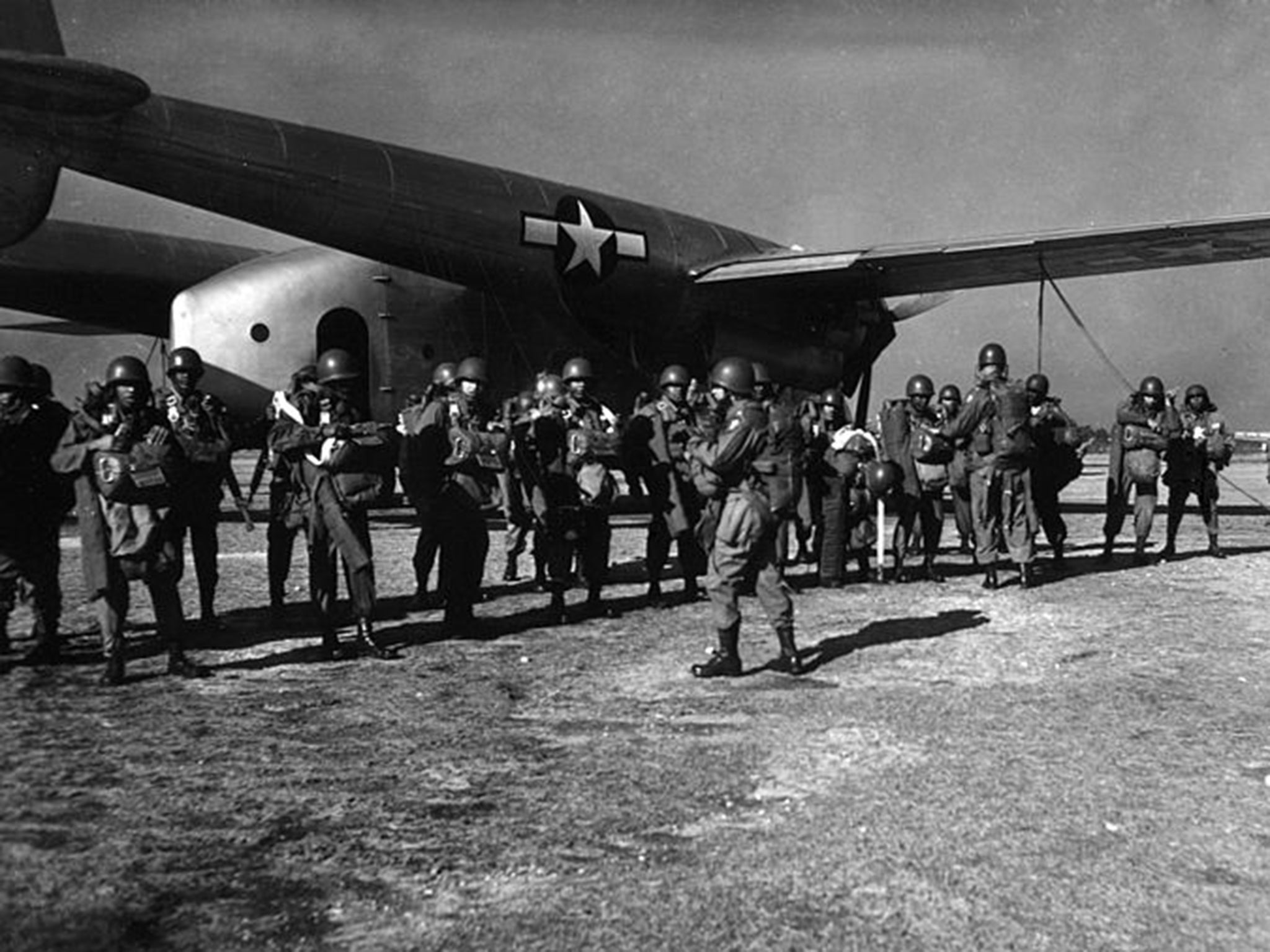Clarence Beavers: Veteran of America’s first ‘test’ platoon of black paratroopers in the Second World War
While he never faced enemy fire, he was dispatched with fellow African-Americans to fight fires caused by Japanese bombardment on the US mainland – they were only recognised in 2010

Clarence Beavers, who has died aged 96, was the last surviving member of America’s first black parachute unit.
The New Yorker was part of a “test” platoon sent to combat fires caused by Japanese bombs in the Second World War, which paved the way for black paratroopers in the US army.
Beavers never came under enemy fire during his service. But for one summer towards the end of the war, he repeatedly leapt towards smoke and flames, jumping from a C-47 transport plane to steer his parachute towards remote stretches of the Pacific Northwest.
His unit, which formed the original core of the 555th Parachute Infantry Battalion – or Triple Nickles – was never as well known as the Tuskegee Airmen or Buffalo Soldiers.
Yet the 17-member group played a seminal role in the integration of the military and the development of smoke-jumping: a novel firefighting method. Forest fires, sparked by Japanese bombs carried by balloons, were tackled by men who protected themselves with modified football helmets and willfully landed in trees.
“Nobody in those days figured that black folks had either the courage or the intelligence to do anything white folks would do,” said Joe Murchison, a retired Triple Nickles paratrooper who now heads the 555th Parachute Infantry Association.
“Our first paratrooper had one of the white trainers bet his house that he wouldn’t jump out of the airplane. Well, he jumped out of the plane. He didn’t get the house.”
In an era when segregation still reigned, black soldiers were prohibited from serving as paratroopers when the US airborne took flight in 1940. Three years later, after a military advisory committee recommended the creation of a black parachute battalion, Beavers was among the first to volunteer, leaving behind his Army maintenance platoon in Pennsylvania to travel to the parachute school at Fort Benning, Georgia.
He was met with surprise from the school’s commanding officers and shock from its white soldiers, including the man who drove him from the train station to the fort.
“Every time we came past one of them streetlights, he would glare over and look at me,” Beavers told the New York Daily News in 2000. “I said, ‘I’m coloured. Now, will you please drive this damn Jeep before you kill us both?’”
Beavers was the first volunteer of what was known as the test platoon of black paratroopers, a unit that was meant to decide the fate of African Americans in the airborne. In what he later recalled was “extremely rough and extremely personal training”, he and his fellow black soldiers slept two-to-a-bunk in a cramped, unheated hut and ate separately from their white peers in the mess hall.
German prisoners of war experienced better conditions at the base, platoon members later said.
Still, 17 of the unit’s 20 original members successfully earned their wings, becoming the founding members of the all-black 555th.
Beavers and his fellow paratroopers had assumed they would soon see combat in Europe, where their white counterparts were participating in battles that would later be memorialised in the television series Band of Brothers.
Instead, they were sent to Pendleton, Oregon, where in 1945 they worked with the US Forest Service on a secret mission called Operation Firefly. Beavers and more than a hundred members of the 555th were tasked with extinguishing fires started by Japanese bombs that had floated over to the US mainland.
“It was really a kind of terrorism operation,” said Lincoln Bramwell, chief historian for the Forest Service, who noted that six people were killed from one of the bombs in 1945 – the only reported combat casualties on America’s mainland during the war.

The Triple Nickles responded to about three dozen fire calls and performed more than 1,200 individual jumps, putting out fires started by bombs as well as by lightning or other natural causes. Working with crosscut saws, shovels and a combination digging-cutting tool called a Pulaski, they sought to starve fires using similar methods to those of contemporary smoke jumpers.
Contrary to their training when they practised landing in open fields, they avoided the risk of landing in a rock-strewn meadow or prairie and aimed for the trees themselves – wearing a protective helmet that mixed elements of a football helmet and mesh-faced fencing mask to guard against stray branches.
Nearly every jump ended with an injury, said Beavers. One paratrooper, Malvin L Brown, became the first reported smoke jumper to die when he fell after landing in a tree in 1945.
Beavers himself suffered a back injury that ended his army career that same year, his daughter Charlotta Beavers said, after strong winds forced him to land upside down.
“At first we were bitter,” Beavers told Newsday in 2004, describing his feelings after learning that he and his battalion would not be sent into combat. “We thought: ‘They’ve taken away our rifles and given us picks and shovels.’
“But as we learned about the dangers involved and the lives we could save, we began to take real pride in our work.”
Clarence Hylan Beavers was born in Manhattan in the early Twenties: the second youngest of 16 siblings. His maternal grandfather was a former slave who fought for the Union in the Civil War, and his father was a commercial artist for Ringling Bros who fled to New York from Alabama, where according to his son he had helped protect all-black Talladega College from being burned by the Ku Klux Klan.
The younger Beavers enlisted in the New York National Guard after graduating from high school in 1939, and two years later was drafted into the army. A brother, Leo Beavers, was a signal corpsman in North Africa and Italy.
Beavers was discharged from the Army as a staff sergeant after his injury, and his battalion was deactivated and became part of the 82nd Airborne Division. The entire military was integrated in 1948 following an executive order from President Harry S Truman.
Beavers later worked on computer systems for the Veterans Administration, and for many years lived in Germany while developing a computerised payroll system for the US Defence Department. He retired in 1978 and, in a land-bound twist on his earlier occupation, served as a volunteer firefighter in Upstate New York.
Survivors include his wife of 59 years, the former Edolene Davis of Huntington; six children, Patricia Merritt, Dawn Hargrove, Charlayne, Charlotta and Charris Beavers, and Clarence Beavers II; three grandnephews whom he raised, Delwyn Davis and Dion Davis and Dwayne Davis; 18 grandchildren; 22 great-grandchildren; and 10 great-great-grandchildren.
Beavers and his test platoon received relatively scant recognition from the military until 2010, when he and two other since-deceased paratroopers in the unit were honoured at the Pentagon.
“These three gentlemen,” said Michele S Jones, a retired paratrooper and Defence Department official, “opened the door, they kicked open the door, they took the door off the hinges.”
Clarence Beavers, US army paratrooper and firefighter, born 12 June, died 4 December 2017
© The Washington Post
Join our commenting forum
Join thought-provoking conversations, follow other Independent readers and see their replies
Comments